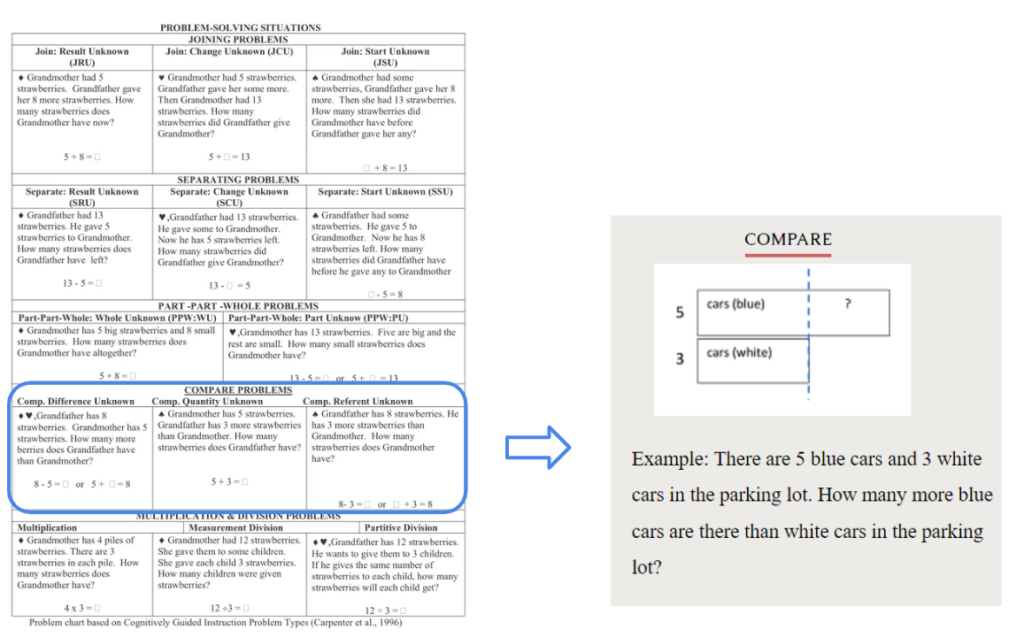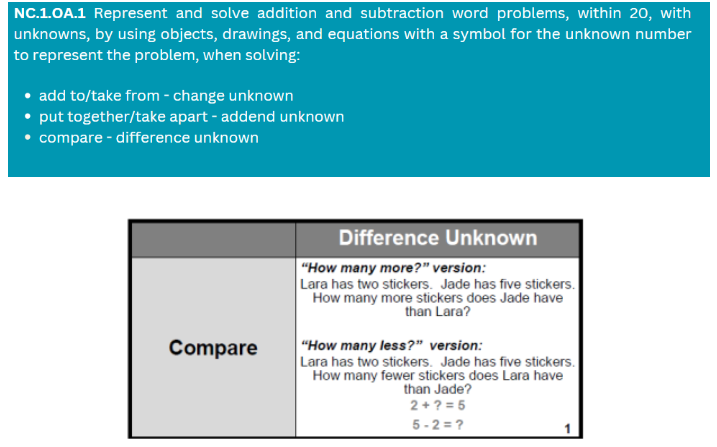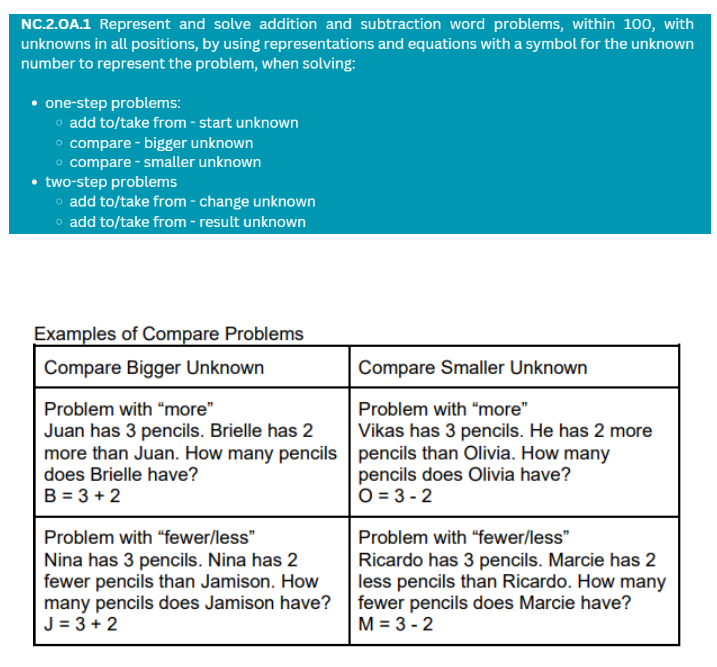January 10, 2024
Last week, we went in-depth with the Parts Equal Total structure as a reading comprehension tool for teaching math word problems. Today, we’re diving into Compare. We’ll explore:
- sample 1st, 2nd, & 4th grade story problems
- How they relate to CGI
- How the Compare structure relates to the standards
- The gaps filled by Structures of Equality (SoE)
You may notice I skipped 3rd grade. That’s because a new problem type is not introduced. Students will use the Compare structure to solve problems similar to previous grades, but with larger numbers.
Worth repeating
In my last blog, I talked about how to introduce all the structures. I’ve repeated some of the information below because it’s that important.
Structures of Equality (SoE) aren’t procedures. There’s not a specific step-by-step process to follow. But there are key teacher moves you need to make every time. Before we narrow our focus to Compare, let’s start with the big picture.
But before you use any structure to visually represent a number story, you have to start with an in-depth discussion.
Here are a few of my go-to story element questions:
- What do you notice?
- What’s happening in the story?
- What’s the setting?
- Who are the characters?
- What’s the action? (What’s the verb?)
- What’s the math main idea?
- What’s the thing we’re counting?
- Close your eyes and visualize the story. Have you ever had (item)?
- What’s a (item)?
Once students have an understanding of the context, you’re ready to think about how to represent it with a structure. There are 3 structures and they can be used to represent any problem in the K-5 NC Standard Course of Study (which correlates very closely with Common Core standards). Today, we’ll explore one of them.
What does it look like to model a story problem with a Compare structure?
The Compare SoE is used when a math story describes a situation where quantities are being compared. These are math stories in which the question is usually “how many more?” or “how many less?”. In a previous blog, you were introduced to the Compare structure and had a chance to see students in action. I also shared how problems with comparison relationships are the most challenging for students who have been taught to look for keywords.
Today I’m sharing two videos I created showing you how to teach problems that involve comparing.
? Xbox problem – how many less/fewer?
? book problem – multiplicative comparison
How Compare structures relate Cognitively Guided Instruction (CGI)
There are 3 CGI problem types that can be represented with a single structure, Compare. This allows students to focus on the relationships and create a visual representation before they worry about symbolic representations.

How does the Compare structure support understanding of 1st-grade word problems?
In the 1st grade standards, students are expected to write equations to match story problems. They represent unknown values with symbols and work on problems that involve comparison situations in which the difference is unknown.

When students see the word more, they tend to “plug and chug”. They pluck the numbers they see out of the problem and add them. Unless they understand the context of the problem and how to visually represent it. This is exactly what the Compare SoE allows them to do.
In this structure, the line of equality is particularly important. We don’t need to draw it in other structures because both bars are the same size, implying equality. Here, it allows students to see the more (or the fewer), depending on the context of the problem.

How does Compare structure support understanding of 2nd-grade word problems?
In 2nd grade, students begin to work with larger numbers and two-step story problems. They also represent different unknown values with symbols.

Instead of having to consider 4 CGI problem types, all of these problems can be solved with the same structure. This allows students to comprehend what is happening before attempting to write an equation.
How does Compare structure support understanding of 4th-grade word problems?
In 4th grade, students begin to deal with multiplicative comparisons. Up until this point, they’ve dealt with multiplication problems in which there are an amount of groups and a number of items in each group.

As you watched in the video above, the Compare structure helps students visualize the math story and relate it to the multiplication concepts they learned previously.
Conclusion
Story problems that include comparisons are often the most challenging for students (and teachers). Because of the frustration that occurs, teachers and students alike try to find simpler methods for solving. They tend to revert to ineffective strategies such as CUBES, which is a series of procedural steps that don’t require comprehension.
By using the Compare structure, students are able to physically see the point up to which the values are equal and where the “more” or “fewer” is. This allows them to easily write equations for what could be complicated problems otherwise.
Learning to implement SoE takes time, patience, and consistency. It’s not a quick fix for word problem struggles. However, once students internalize the structures, they have the tools they need to solve any problem type in the K-5 standards.
Resources:
NC Department of Public Education. (2022, June). 1st Grade Mathematics Unpacked Content. https://www.dpi.nc.gov/nc-1st-grade-math-unpacking-rev-june-2022/open
NC Department of Public Education. (2022, June). 2nd Grade Mathematics Unpacked Content.https://www.dpi.nc.gov/nc-2nd-grade-math-unpacking-rev-june-2022/open
NC Department of Public Education. (2022, June). 4th Grade Mathematics Unpacked Content https://www.dpi.nc.gov/nc-4th-grade-math-unpacking-rev-june-2022/open